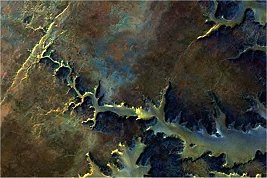

 |
Wadi Bakht |
When Bagnold and company entered Wadi Bakht in 1938, they found that the middle section of the wadi was blocked by a large transverse dune. Behind this dune a lake formed in prehistoric times, that probably went through several cycles of breaching and refill. Olivier Myers, the archaeologist of the expedition, spent a number of days excavating neolithic sites on the dry lakebed, and on the dune itself. Despite the numerous expeditions to the region, the wadi remained the only site whose archaeology had been properly studied up to the early 1980s.
Apparently there was very little water erosion after the lake drained for the last time. There is a short deep canyon cut into the sediments at the point where the dam was breached, but this does not extend very deep into the lakebed, and the subsequent erosion channel is only a few inches deep.

longitudional section of the valley floor, drawn by O.H. Myers (GJ XCIII/4, 1939)
The lakeshore, and the intermittently dry lakebed must have supported lush vegetation, that is attested by the abundant remains of fossilized root casts visible along the eroded banks of drainage channel.
Unfortunately Myers did not publish any detailed account of his findings, but the material he recovered is still available at the Musée de l'Homme in Paris. William McHugh examined and published these materials in 1975, and subsequently the Heinrich Barth Institut conducted several excavations in the wadi. See:

|

|

|